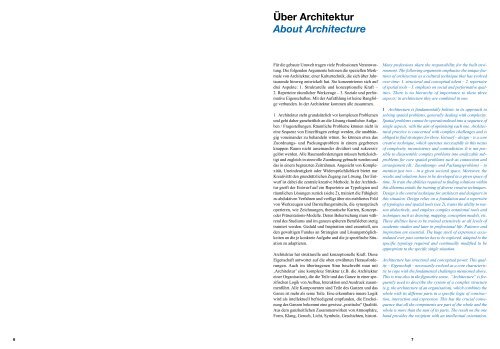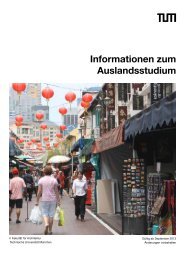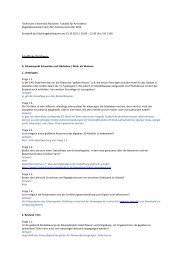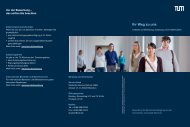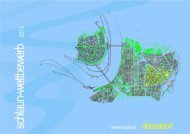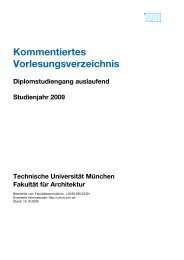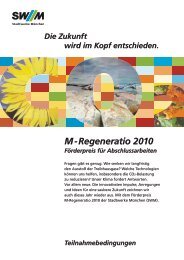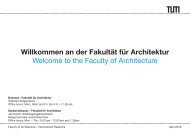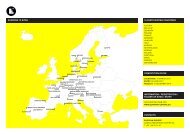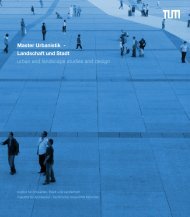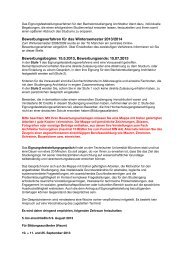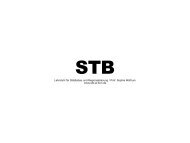Institute Institutes - Fakultät für Architektur - TUM
Institute Institutes - Fakultät für Architektur - TUM
Institute Institutes - Fakultät für Architektur - TUM
Erfolgreiche ePaper selbst erstellen
Machen Sie aus Ihren PDF Publikationen ein blätterbares Flipbook mit unserer einzigartigen Google optimierten e-Paper Software.
Über <strong>Architektur</strong><br />
About Architecture<br />
Für die gebaute Umwelt tragen viele Professionen Verantwortung.<br />
Die folgenden Argumente betonen die speziellen Merkmale<br />
von <strong>Architektur</strong>, einer Kulturtechnik, die sich über Jahrtausende<br />
hinweg entwickelt hat. Sie konzentrieren sich auf<br />
drei Aspekte: 1. Strukturelle und konzeptionelle Kraft –<br />
2. Repertoire räumlicher Werkzeuge – 3. Soziale und performative<br />
Eigenschaften. Mit der Aufzählung ist keine Rangfolge<br />
verbunden. In der <strong>Architektur</strong> kommen alle zusammen.<br />
1 <strong>Architektur</strong> steht grundsätzlich vor komplexen Problemen<br />
und geht daher ganzheitlich an die Lösung räumlicher Aufgaben<br />
/ Fragestellungen. Räumliche Probleme können nicht in<br />
eine Sequenz von Einzelfragen zerlegt werden, die unabhängig<br />
voneinander zu behandeln wären. So können etwa das<br />
Zuordnungs- und Packungsproblem in einem gegebenen<br />
knappen Raum nicht auseinander dividiert und sukzessiv<br />
gelöst werden. Alle Raumanforderungen müssen berücksichtigt<br />
und zugleich in sinnvolle Zuordnung gebracht werden und<br />
das in einem begrenzten Zeitrahmen. Angesicht von Komplexität,<br />
Uneindeutigkeit oder Widersprüchlichkeit bietet nur<br />
Kreativität den grundsätzlichen Zugang zur Lösung. Der Entwurf<br />
ist dabei die zentrale kreative Methode. In der <strong>Architektur</strong><br />
greift der Entwurf auf ein Repertoire an Typologien und<br />
räumlichen Lösungen zurück (siehe 2), trainiert die Fähigkeit<br />
zu abduktiven Verfahren und verfügt über ein etabliertes Feld<br />
von Werkzeugen und Darstellungsmitteln, die synergetisch<br />
operieren, wie Zeichnungen, thematische Karten, Konzept-<br />
oder Präsentations-Modelle. Deren Beherrschung muss während<br />
des Studiums und im ganzen späteren Berufsleben stetig<br />
trainiert werden. Geduld und Inspiration sind essentiell, um<br />
den gewaltigen Fundus an Strategien und Lösungsmöglichkeiten<br />
an die je konkrete Aufgabe und die je spezifische Situation<br />
zu adaptieren.<br />
<strong>Architektur</strong> hat strukturelle und konzeptionelle Kraft. Diese<br />
Eigenschaft antwortet auf die oben erwähnten Herausforderungen.<br />
Auch im übertragenen Sinn beschreibt man mit<br />
‚<strong>Architektur</strong>’ eine komplexe Struktur (z.B. die <strong>Architektur</strong><br />
einer Organisation), die die Teile und das Ganze in einer spezifischen<br />
Logik von Aufbau, Interaktion und Ausdruck zusammenführt.<br />
Alle Komponenten sind Teile des Ganzen und das<br />
Ganze ist mehr als seine Teile. Eine erkennbare innere Logik<br />
wird als intellektuell befriedigend empfunden, die Erscheinung<br />
des Ganzen bekommt eine gewisse „poetische“ Qualität.<br />
Aus dem ganzheitlichen Zusammenwirken von Atmosphäre,<br />
Form, Klang, Geruch, Licht, Symbole, Geschichten, histori-<br />
6 7<br />
Many professions share the responsibility for the built environment.<br />
The following arguments emphasise the unique features<br />
of architecture as a cultural technique that has evolved<br />
over time: 1. structural and conceptual talent – 2. repertoire<br />
of spatial tools – 3. emphasis on social and performative qualities.<br />
There is no hierarchy of importance to these three<br />
aspects; in architecture they are combined in one.<br />
1 Architecture is fundamentally holistic in its approach to<br />
solving spatial problems, generally dealing with complexity.<br />
Spatial problems cannot be operationalised into a sequence of<br />
single aspects, with the aim of optimising each one. Architectural<br />
practice is concerned with complex challenges and is<br />
obliged to find strategies for these. Entwurf – design – is a core<br />
creative technique, which operates successfully in this nexus<br />
of complexity, inconsistency and contradiction. It is not possible<br />
to disassemble complex problems into analyzable subproblems<br />
for core spatial problems such as connection and<br />
arrangement (dt.: Zuordnungs- und Packungsproblem) – to<br />
mention just two – in a given societal space. Moreover, the<br />
results and solutions have to be developed in a given space of<br />
time. To train the abilities required to finding solutions within<br />
this dilemma entails the training of diverse creative techniques.<br />
Design is the central technique for architects and designers in<br />
this situation. Design relies on a foundation and a repertoire<br />
of typologies and spatial tools (see 2), trains the ability to reason<br />
abductively, and employs complex notational tools and<br />
techniques such as drawing, mapping, conception models, etc.<br />
These abilities have to be trained extensively at all levels of<br />
academic studies and later in professional life. Patience and<br />
inspiration are essential. The huge stock of experience accumulated<br />
over past centuries has to be explored, adapted to the<br />
specific typology required and continually modified to be<br />
appropriate to the specific single situation.<br />
Architecture has structural and conceptual power. This quality<br />
– Eigenschaft – necessarily evolved as a core characteristic<br />
to cope with the fundamental challenges mentioned above.<br />
This is true also in the figurative sense. “Architecture” is frequently<br />
used to describe the system of a complex structure<br />
(e.g. the architecture of an organisation), which combines the<br />
whole with its different parts in a specific logic of construction,<br />
interaction and expression. This has the crucial consequence<br />
that all the components are part of the whole and the<br />
whole is more than the sum of its parts. The result on the one<br />
hand provides the recipient with an intellectual orientation,


